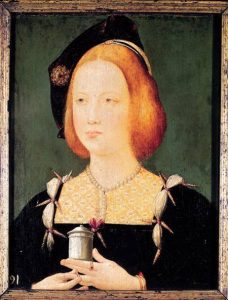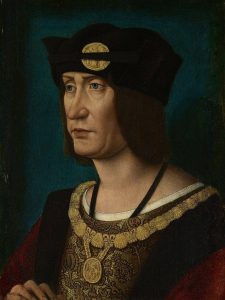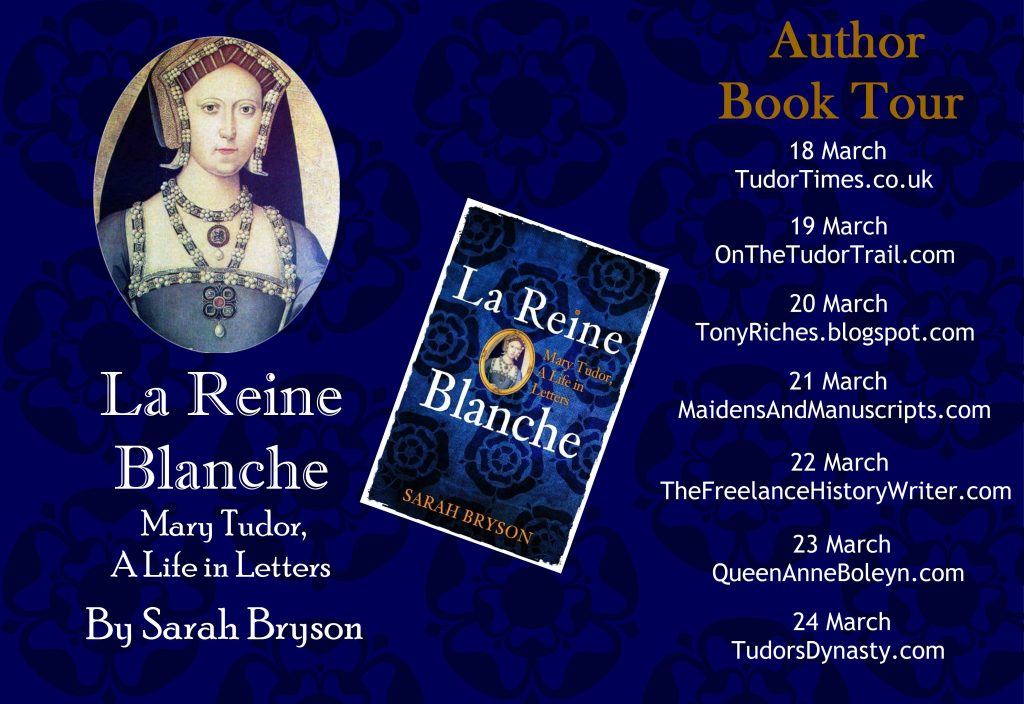I’m delighted to be hosting Day 2 of Sarah Bryson’s book tour for her new biography, ‘La Reine Blanche: Mary Tudor, A Life in Letters’. I’m sure you will enjoy this fascinating extract from Sarah’s book.

Thank you so much to Natalie for hosting me at her website today! I wanted to share an extract from my book ‘La Reine Blanche: Mary Tudor a Life in Letters’, focusing on Mary Tudor’s coronation and her extravagant entrance into Paris. The city went all out to welcome their new Queen!
Extract: Mary Tudor’s Coronation and Entrance into Paris

This portrait is possibly Mary Tudor by Jean Perreal.
Mary was crowned Queen of France on Sunday, 5 November 1514. Early in the morning the English Ambassadors were informed by Monsieur de Montmorency that they needed to make their way to the cathedral of St Denis so they could take their seats before other, less important people arrived. At ten o’clock there was a great blast of trumpets signalling Mary’s arrival. A few moments later the French members of nobility arrived including the Ducs d’Alençon, Bourbon, Longueville and Albany, the Comte de Vendôme and the Comte de Saint-Pol. After them came Mary. There are no accounts of what Mary wore for her coronation; for such a momentous occasion it surely must have been a gown of the most dazzling design and material. Mary was led by the hand through the cathedral by Francis d’Angoulême to a cushion in front of the high altar. Mary knelt and the Cardinal de Brie stepped forward anointing Mary with the sacred oil before placing the royal sceptre in her right hand and the rod of justice in her left. The Cardinal then placed a ring on Mary’s finger and the matrimonial crown of France on her head. After this Francis stepped forward and helped Mary to her feet before guiding her to the chair of state beneath a canopy on the left side of the altar. The crown was so heavy that Francis had to move to stand behind where Mary sat so that he could hold the crown symbolically above the new queen’s head. High Mass was then sung by Cardinal de Brie before Mary once more approached the altar. She made an offering before receiving the sacrament. Once this was done the ceremony was officially over and Mary left the cathedral of St Denis with her ladies and other nobles to return to her apartments where she was joined by Louis XII, who had been secretly watching the coronation.

Louis XII
While Mary’s coronation had been a relatively low key affair, her entrance into Paris would be one of the grandest spectacles ever held. At seven o’clock the following morning, Louis XII left St Denis early so that he could await the arrival of his wife and new queen. Mary left shortly after nine o’clock. The French queen rode in an open carriage covered with a cloth of gold. She wore a magnificent gown of gold brocade covered in pearls and a jewelled necklace. At eighteen, dressed in cloth of gold, her breathtaking jewellery sparkling, Mary must have looked like a goddess. Francis d’Angoulême rode by Mary’s side, the pair it is reported, often speaking to one another. It must have been over the last few days that Mary began to acquaint herself with her son-in-law and gain an opinion of him; it would be a relationship which she would rely on heavily after the death of her husband. Behind Mary rode her ladies, as well as Louis’ daughters, Claude and Renée.
Paris was bedecked to welcome the new queen. Tapestries hung along the streets and the entire town was decorated with lilies and roses. On her journey there Mary was greeted by a number of tableaux. The first was at St Denis. Here an enormous ship had been built, complete with real sailors who climbed the rigging. There was even wind blowing into the sails. The ship held images of Ceres, Bacchus and at the helm the Greek hero, Paris. These symbolised the corn, wine and general commerce of the city. Mary was presented with a carefully written programme of the tableaux illuminated with gold leaf. A choir sung her praises,
Noble Lady, welcome to France,
Through you we now shall live in joy and pleasure,
Frenchmen and Englishmen live at their ease,
Praise to God, who sends us such a blessing!
Most illustrious, magnanimous Princess, Paris reveres and
honours you
And presents this ship to your nobility,
Which is under the King’s governance.
Grains, wines, and sweet liqueurs are therein,
Which the winds propel by divine ordinance.
All men of good will
Receive you as Queen of France.
To Mary, who has replaced war
By peace, friendship, and alliance,
Between the Kings of France and England.
Mary progressed to the second tableau, which was a beautiful marble fountain in front of a background of celestial blue. The three Graces danced in the surrounding garden while lilies of France and English roses grew out of the fountain. A further poem celebrating the joining of the lily and the rose was read.
The third tableau displayed Solomon and the Queen of Sheba representing the wisdom of Louis XII. The fourth tableau was at the Church of the Holy Innocents. A two-tiered scaffold had been erected at the front of the church and a person dressed as God the Father held a large heart and a bouquet of red roses over figures of Louis and Mary, now both dressed in gold and ermine.
The fifth tableau was the most spectacular. A grand walled city had been constructed enclosing a garden in which grew a rose bush. By a great feat of design a magnificent rose bud grew upwards out of the bush towards a balcony where a lily was growing before a golden throne, covered in a beautiful pavilion. When the rosebud reached the lily, it opened to reveal a young woman. The woman then recited a poem comparing Mary to love. This entire scene was watched by four Virtues and from outside the constructed walls, Peace, who had vanquished the evil of Discord.
Continuing her journey Mary was presented with the sixth tableau at the Chastellet de Paris. Here the virtues of Justice and Truth sat on thrones beneath a grant replica of the French crown. Surrounding them the god and goddesses Phoebus, Diana, Minerva, Stella Maris and Concord sat in a meadow listening contentedly to a long speech comparing Louis to the sun and Mary to the moon.
Late in the afternoon Mary finally reached the seventh and final tableau at the Palace Royale. Here the Angel of the Annunciation, Gabriel, spoke to the Virgin Mary who sat under the coat of arms of France, which was supported by a porcupine and a lion. The lion represented England, the porcupine the French Order of the Porcupine established in 1394 by Louis de France, Duke of Orléans. At the foot of the stage, shepherds and shepherdesses sang a song celebrating Mary in heaven and Mary on earth.
As the peace between God and man,
By the intervention of the Virgin Mary,
Once was made, so now we,
The French burghers, are relieved of our burdens;
Because Mary has married with us.
Through her, justice and peace join
In the fields of France and the countryside of England;
Since the bonds of love hold arms in restraint,
We have acquired for ourselves, equally,
Mary in heaven and Mary on earth.
After this final tableau Mary and her entourage travelled to Notre Dame where she was greeted by all the learned men of the city: doctors, lawyers and members of the Church. As Mary entered the great cathedral bells were rung and the organ began to play. As she made her way to the high altar the clergy sung the Te Deum. A Mass was conducted and Mary was formally welcomed to the city by the Archbishop of Paris. Mary returned to her litter and she and all those who accompanied her returned to the Palace Royale at around six o’clock.
The banquet was held in the Grande Salle, a spectacular room 222 feet long and 84 feet wide. The room had been built with supporting Doric columns and the walls were lined with effigies of all the French kings. Tapestries hung about the walls and large sideboards covered with gold and silver plate surrounded each pillar showing the wealth of the French king. Musicians played light music while Mary and her guests ate.
Seated at a marble table, Mary was joined by her daughter-in-law Claude, Louise of Savoy, (Francis’ mother) and Louise’s daughter, Marguerite of Navarre. For Mary this must have been a rather tense situation. Unless Mary bore her husband a son it would be Francis who inherited the French crown. Louise of Savoy was a fierce woman, devoted to her son as well as being politically astute and an extremely clever diplomat. Louise would have been very much aware of how tenuous her son’s claim to the throne had become with Mary’s marriage to Louis. The subject of their conversation remains unknown; both knew the implications of this marriage.
The banquet consisted of a mixture of culinary and mechanical extravaganzas including a phoenix beating its wings until it was consumed by fire, a cock and a hare jousting and an image of St George on horseback leading a damsel. After the dishes were served Mary thanked the heralds and musicians and gave them an alms dish and plate worth around 200 crowns. After everyone had eaten, a number of ‘pastimes and diversions’ were provided. It is reported that Mary fell asleep before the banquet was over, utterly exhausted from the rigours of the day and that she had to be carried to her rooms. Louis had retired some time earlier.
 About the Author
About the Author
Sarah Bryson is a researcher, writer and educator who has a Bachelor of Early Childhood Education with Honours. She currently works with children with disabilities. She is passionate about Tudor history and has a deep interest in Mary Tudor, Charles Brandon, Duke of Suffolk and the reign of Henry VIII and the people of his court. She has run a website dedicated to Tudor history for many years and has written for various websites including ‘On the Tudor Trail’ and ‘QueenAnneBoleyn’. She has been studying primary sources to tell the story of Mary Tudor for a decade. Sarah lives in Australia, enjoys reading, writing and Tudor costume enactment.
Links


















I enjoyed reading this very much, thank you.